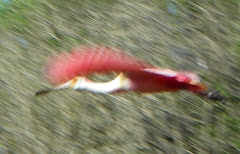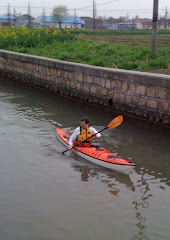I looked down. Goldfish swam in the clear shallows beneath my kayak. I looked up. A beefy water buffalo, heavy, grey, and sturdy-horned chewed nonchalantly at the foliage at the water’s edge. A few yards beyond began the steep green climb to the caldera rim more than two thousand feet above the lake.
 |
| Water Buffalo at the lake edge |
I had not heard of Lake Toba before kayaking guide Priyo Utomo of Legendary Guides tempted me with an invitation to paddle there with him. “We want to discover more about Toba Batak culture,” he explained. “You know they have a paddling culture on the lake?”
 |
| Dugout canoes, solus, are used for fishing |
But where is the lake? Sumatra. In the middle of North Sumatra, Indonesia, south-east Asia. Why focus on this lake? Home in Seattle I was about to discover how Lake Toba is cradled within the caldera of a super-volcano. There are only six known active super-volcanoes worldwide. One better known here in USA is Yellowstone. But the Toba eruption some 74,000 years ago was 2.8 times more powerful than the last Yellowstone eruption. It covered the whole of the Indian subcontinent with ash, in places up to twenty feet deep. Coming from Seattle on the Pacific edge of USA, where a north-south string of volcanoes includes Mount St Helens I have some idea how powerful an eruption can be. St Helens erupted in spectacular fashion in 1980 in the biggest, costliest, and deadliest eruption in US history. Toba’s was 2,800 times more powerful.
 |
| The caldera holds lake Toba in its bowl |
A lake? Yes, Toba is a lake some sixty miles long and eighteen miles wide. With Samosir Island, the lake looks like an elongated doughnut on the map. Samosir Island is the volcano’s resurgent dome. It grew after the eruption when magma pushed up what had become the lake floor. Known as the Heart of Toba,
Samosir was once the home of two hundred small and often warring kingdoms. The tribes became subdued under Dutch colonialism and German Protestantism in the late 19th and early 20th centuries, but until 1852 no European had set eyes on the lake. You will not see it on any earlier maps. The area was guarded by difficult terrain and forest, and by tribes who preferred to eat strangers alive rather than let them pass. Batak chiefs gained prestige by collected human heads.
So kayaking on Lake Toba might be risky? No, although Toba Batak still prepare spicy sambal, those legendary and often mouth-searing chili-hot sauces, they no longer use them to season human flesh.
 |
| Spices and sambals brighten flavors |
Nowadays you are more likely to face the danger of becoming accustomed to the high quality of some of the locally grown arabica coffees, perhaps served as latte with creamy milk from the water buffalo, and something you might struggle to find the equal of elsewhere.
 | ||
| Priyo holds crayfish from fisherman's catch | |
We began our journey by sea kayak along the lake toward our
first destination Sibandang Island, where we hoped to visit local weavers. We wanted to
learn how they used back-strap looms to weave ulos, the traditional Batak cloth.
Ulos has much symbolism. It can be worn over a shoulder, or over both, or
wrapped as a headdress, and it appears in many important Batak ceremonies. Yet
if Sibandang was our first destination, I had much to learn along the way. Plastic
bottles littered the water, but when I detoured to pick one up, I discovered it
was tied securely to a line that dropped into the deep. It was being used as a
fishing float for a pot, or a net. Ahead
I could see a man in a small canoe. Could he tell me which? I will elaborate in my next Toba blog post... but you'll find much more in my book Heart of Toba.
 |
| Learn more in Heart of Toba |

































No comments:
Post a Comment